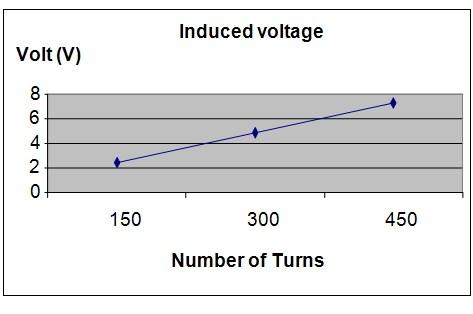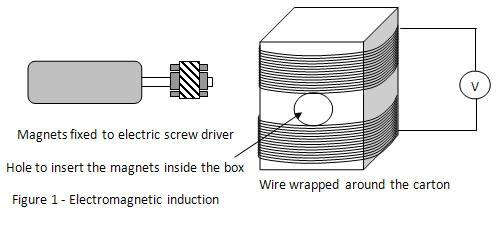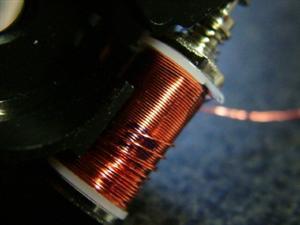| Complexity level: | 8 |
| Project cost ($): | 70 |
| Time required: | 1 day to prepare, 1 day for experiment |
| Material availability: | The wires can be purchased at a hardware shop. |
| Safety concerns: | Basic safety requirements |
Hypothesis
The coil that has many turns will have the highest voltage. Thus, the greater the number the turns, the higher the voltage.
Overview
Electromagnetic induction
Electromagnetic induction occurs when a current is induced in a coil by a changing magnetic field. When either the magnet moves in relation to the coil or the coil moves in relation to the magnet, a current will be induced in the coil. However if there is no relative movement between the coil and the magnet, there will not be any current induced in the coil.
The induced voltage in the coil is proportional to the number of turns in the coil and the rate of change of the magnetic flux.
Induced voltage = - Number of coil turn x rate of change of magnetic flux.
Therefore the induced voltage in the coil can be increased by:
- increasing the number of turns in the coil,
- increasing the speed of relative movement between the coil and the magnet.
Scientific Terms
Materials
The materials required for this science project:
- an electric screw driver
- 4 magnets
- 1 roll of masking tape
- 3 hollow boxes of the same size.
- 1 spool of insulated wire (PVC insulated or varnish insulated)
- Paper cutter
- 2 crocodile clips
- a digital voltmeter
- a pair of scissors
Procedure
1. For this science project, the independent variable is the number of turns in the coil. The dependent variable is the amount of voltage induced in the coils by the rotating magnet. This is measured by using the digital voltmeter. The constants (control variables) are the speed of the rotating magnets, the strength of the magnets, the size of the copper wire and the size of the box.

2. Using the masking tape, the four magnets are fixed to the shaft of the electric screw driver as shown in figure 1 above.
3. A hole is cut out of the carton box as shown in figure 1. The hole should be large enough to insert the 4 magnets, attached to the shaft of the screw driver, inside the box while holding the handle of the screw driver on the outside.
4. The copper wire is wound around each of the three boxes. The first box is wound with 150 turns, the second box with 300 turns and the third box with 450 turns.
5. Approximately 2 cm of the insulation at the tip of the wires are removed using the paper cutter.
6. The first box with 150 turns is selected first. The ends of the wires are fixed to the digital AC voltmeter using the crocodile clips. The magnets that are attached to the electric screw driver are inserted into the hole in the box. The screw driver is turned on and it will start to spin inside the box. The voltage measured on the digital AC meter is recorded in the table given below.
7. Procedure 6 is repeated using the boxes with 300 turns and 450 turns.


Results
The results show that increasing the number of turns in an electromagnet's coil, will result in an increase in the induced voltage caused by the changing magnetic field.
|
Number of turns in the coil |
150 |
300 |
450 |
|
AC voltage measured (V) |
2.45 |
4.90 |
7.35 |
The graph below represents the results of our experiment.

Conclusion
The hypothesis that the voltage induced in a coil under the influence of the magnetic field of a moving magnet will increase if the number of turns in the coil is increased is proven to be true. The induced voltage in the coil is found to be proportional to the number of turns in the coil.
The use of magnetic induction can be found in electromagnets, motors and transformers. Hydroelectric power stations and wind turbine generators apply the same principle to convert the mechanical energy of a rotating shaft connected to a magnet into electricity.
Also consider
The science fair project can perhaps be repeated by varying the speed of the screw driver.
This experiment can also be modified by keeping the magnets in a fixed position and instead, rotating the coil.
References
Electromagnetic induction - http://electricitymagnetism.suite101.com/article.cfm/magnetic_induction
How to generate free electricity using magnets - http://www.articlesbase.com/diy-articles/how-to-generate-free-electricity-using-magnets-1038086.html

